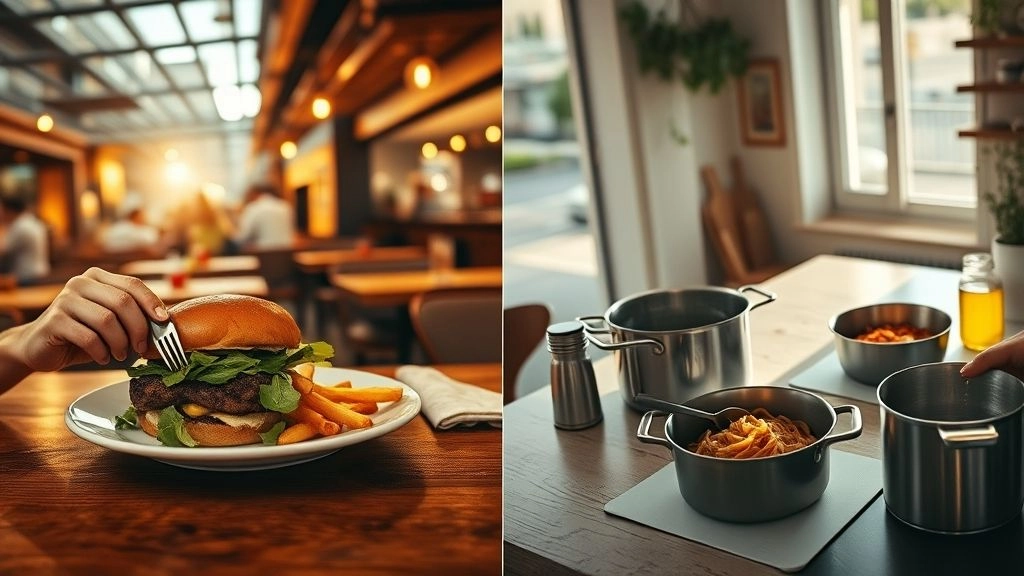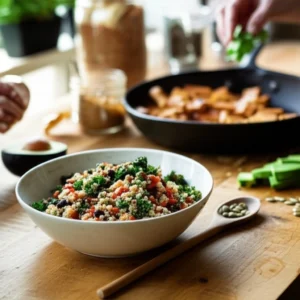Think about the last time you ordered takeout or grabbed dinner at a restaurant. Was it the convenience, the flavors, or just a well-deserved treat? Now, imagine what that same meal would cost—if you made it yourself at home. Odds are, your wallet would thank you for cooking up something in your own kitchen. Over the years, I’ve realized that balancing eating out and eating at home isn’t just a lifestyle choice—it’s a smart move for your budget and sometimes, your sanity.
So, let’s unpack some real talk on the eating out vs eating at home pros and cons. I promise, no boring lectures—just friendly advice, sprinkled with money-saving gems and maybe a little kitchen inspiration (or confession of kitchen fails!). Ready? Let’s dive in.
Why Ditch The Menu?
Ever Wonder About Hidden Costs?
Have you noticed how a simple restaurant meal quickly balloons into a bigger bill? You start with that juicy burger, add fries, maybe a drink, and suddenly that $15 meal turns into $25 after tax and tip. And don’t even get me started on delivery fees and those sneaky “small” extras like appetizers or dessert you hadn’t even planned for.
Unlike eating out, when you cook at home, you’re paying mainly for the ingredients—no rent, no tips, no delivery hikes. Plus, you get leftovers sometimes, which means more meals for less money. A recent cost of eating out vs cooking at home study found that a home-cooked meal costs an average of just $4 to $6, while restaurant meals can hit $15 to $20 or more per person. That’s an easy $10 or more saved for each meal you make at home.
Quick Cost Breakdown
| Meal Type | Eating Out (Avg. Cost) | Home-Cooked (Avg. Cost) | Savings Per Meal |
|---|---|---|---|
| Burger & Fries | $15 | $4 | $11 |
| Pasta Dish | $18 | $5 | $13 |
| Salad | $12 | $3 | $9 |
So yeah, that fast food run feels fun in the moment, but these dollars add up fast. An essay on why cooking at home is cheaper breaks down how those regular “treat yourself” meals actually blow your budget over time.
Convenience: Worth The Splurge?
I get it. Sometimes after a long day, the thought of whipping up dinner sounds worse than running a marathon. Eating out—or ordering in—is undeniably easy. But here’s a question: is that convenience really worth the cost? And I don’t mean just the dollars but your long-term health and habits, too.
One trick I learned? Batch cooking on weekends. It sounds fancy, but it’s really just making a bunch of meals ahead that you can reheat on busy nights. This way, you get the convenience of “fast food” but with home-cooked prices and control.
Home Wins Big
Health Perks You Can’t Ignore
Here’s something that hit me hard: when you cook at home, you decide exactly what goes into your meals. No hidden sauces loaded with salt or sugar bombs disguised as salad dressings. Studies confirm that restaurant meals tend to be packed with more calories, unhealthy fats, and sodium compared to home-cooked dishes.
Ever look at a menu and wonder why the salads have more calories than the burgers? Not kidding. Research summarized in an eating at home vs eating out essay highlights how restaurant portions are often oversized, pushing us toward overeating.
And the best part? Cooking at home lets you adjust recipes to suit your tastes and health needs—whether that means cutting back on salt, going plant-based, or avoiding allergens.
Budget Boost From Your Kitchen
Honestly, the amount of money you save by cooking your meals could blow your mind. According to a recent analysis, Americans save around $12 per meal by eating at home. Over a year, that’s more than $13,000 in savings just by dialing back restaurant visits. Mind-blowing, right?
I remember a time when my weekly grocery budget was tight, so I started making simple staples like rice, beans, and roasted veggies that could be jazzed up in different ways. Those few dollars saved quickly stacked up. If you want to geek out on the numbers, check out compare and contrast eating at home vs eating out—the breakdown is fascinating.
State-by-State Savings Peek
Did you know the cost difference between eating out and cooking at home actually varies by location? Data from 2025 shows places like New York save the most per meal by cooking at home—up to $19.40. Of course, your mileage may vary depending on where you live, but the trend is clear everywhere: cooking beats eating out for your wallet.
Eating Out Temptations
Social Vibes and Zero Cleanup
Alright, I’m not saying eating out is a villain. It’s social, fun, and a break from chopping and washing dishes (because who really loves dish duty?). Restaurants let you kick back, catch up with friends, or enjoy a date night without stressing the kitchen.
But there’s a catch. Most restaurant meals come with large portions engineered for “value” but often result in overeating. The Obesity Action Coalition points out that this can easily undo your hard work, whether it’s weight goals or just feeling good after a meal.
So, the key might be moderation. A couple of nights out a month? Probably harmless. A restaurant meal every night? That’s another story.
When It’s a Smart Play
And yeah, there are those dishes that just feel too complicated or time-consuming to make yourself. Sometimes, it’s cheaper or less stressful to order that perfect pad thai or sushi. Reddit threads full of frugal folks confirm this—occasional takeout for specialty meals can be part of a balanced budget story.
Pros vs. Cons Side-by-Side
| Aspect | Eating Out Pros | Eating Out Cons | Home Cooking Edge |
|---|---|---|---|
| Time | Instant gratification | Wait times, traffic | Flexible, batch prep |
| Health | Variety of cuisines | High calories/sodium | Custom nutrition |
| Cost | Occasional fun | 7%+ inflation hike in 2025 | $13K yearly savings |
Blend Both For Balance?
Hybrid Hacks For Real Life
Full confession: I don’t eat home-cooked meals every day. But here’s the secret weapon—blend your approach. Maybe you meal prep a few dinners and leave room for a fun outing. Or you cook one weeknight meal, then order in from a favorite place the next.
A little planning goes a long way. Meal planning helps get you out of that “what do I eat?” loop and into a groove that saves money and stress. Amy, a meal-planning enthusiast, swears by it, saying it saves tons of money and wasted food. (And yes, it tastes better too.)
Easy Swaps To Try
- Swap restaurant salads for fresh homemade ones—you can save up to 70%.
- Make pizza dough from scratch for a fraction of takeout costs.
- Use leftovers creatively to avoid waste and extra grocery runs.
If you want more on how to compare and contrast eating at home vs eating out through 2025’s lens, it’s definitely worth a look.
Wrapping It Up
So, what’s the verdict on the classic eating out vs eating at home pros and cons debate? Eating out scores points for convenience, adventure, and social times. But these perks usually come with a hefty price tag—both in dollars and calories. On the flip side, home cooking gives you control, savings, and a health boost. And it doesn’t have to be perfect to be worth it.
Try flipping one dinner a week into a home-cooked win. See how you feel about it: maybe your wallet’s thicker, your energy higher, or the stress a bit lighter. You might find a new favorite recipe or rediscover cooking as a stress buster. (There’s something oddly soothing about stirring a pot that nobody mentions enough.)
Give yourself permission to mix and match—life’s too short for rules you don’t love. Just remember, whenever you’re wondering if that dinner out was worth it, exploring the eating at home vs eating out essay or checking the why cooking at home is cheaper essay can remind you where your money – and health – really flourish.
What’s your favorite simple home-cooked meal that feels like a treat without breaking the bank? Drop a comment or share your story—because we’re all in this money-saving, flavor-loving journey together.













